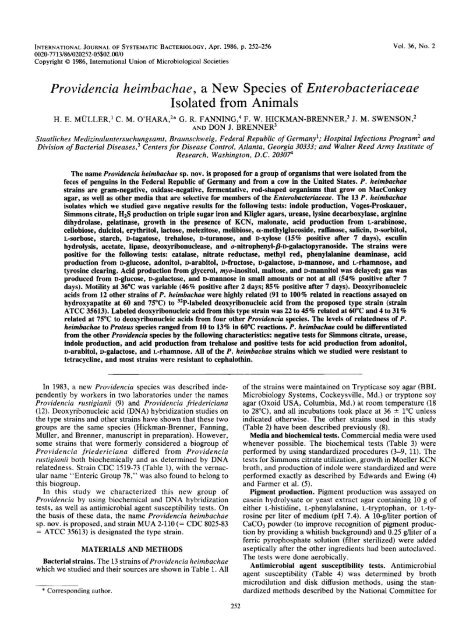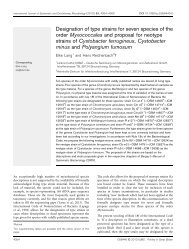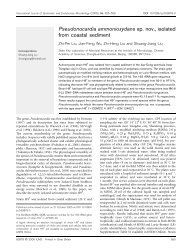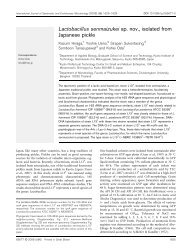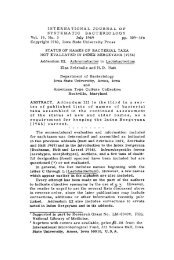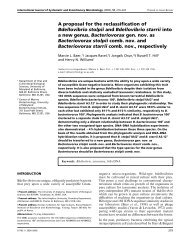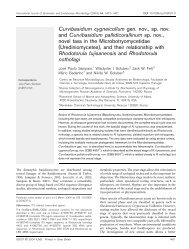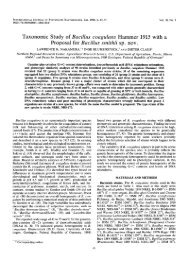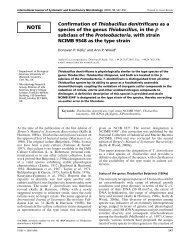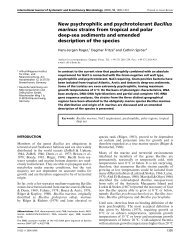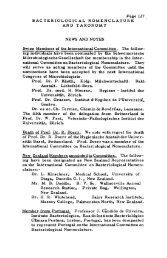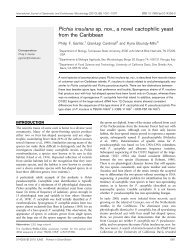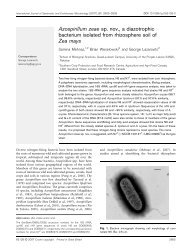Providencia heimbachae, a New Species of Enterobacteriaceae ...
Providencia heimbachae, a New Species of Enterobacteriaceae ...
Providencia heimbachae, a New Species of Enterobacteriaceae ...
Create successful ePaper yourself
Turn your PDF publications into a flip-book with our unique Google optimized e-Paper software.
Apr. 1986, p. 252-256<br />
0020-7713/86/020252-05$02<br />
Copyright 0 1986, International Union <strong>of</strong> Microbiological Societies<br />
INTERNATIONAL JOURNAL OF SYSTEMATIC BACTERIOLOGY,<br />
.OO/O<br />
Vol. 36, No. 2<br />
<strong>Providencia</strong> <strong>heimbachae</strong>, a <strong>New</strong> <strong>Species</strong> <strong>of</strong> <strong>Enterobacteriaceae</strong><br />
Isolated from Animals<br />
H. E. MULLER,l C. M. O’HARA,2* G. R. FANNING,4 F. W. HICKMAN-BRENNER,3 J. M. SWENSON,2<br />
AND DON J. BRENNER3<br />
Staatliches Medizinaluntersuchungsamt, Braunschweig, Federal Republic <strong>of</strong> Germany‘; Hospital Infections Program2 and<br />
Division <strong>of</strong> Bacterial disease^,^ Centers for Disease Control, Atlanta, Georgia 30333; and Walter Reed Army Institute <strong>of</strong><br />
Research, Washington, D.C. 203074<br />
The name <strong>Providencia</strong> <strong>heimbachae</strong> sp. nov. is proposed for a group <strong>of</strong> organisms that were isolated from the<br />
feces <strong>of</strong> penguins in the Federal Republic <strong>of</strong> Germany and from a cow in the United States. P. <strong>heimbachae</strong><br />
strains are gram-negative, oxidase-negative, fermentative, rod-shaped organisms that grow on MacConkey<br />
agar, as well as other media that are selective for members <strong>of</strong> the <strong>Enterobacteriaceae</strong>. The 13 P. <strong>heimbachae</strong><br />
isolates which we studied gave negative results for the following tests: indole production, Voges-Proskauer,<br />
Simmons citrate, H2S production on triple sugar iron and Kligler agars, urease, lysine decarboxylase, arginine<br />
dihydrolase, gelatinase, growth in the presence <strong>of</strong> KCN, malonate, acid production from L-arabinose,<br />
cellobiose, dulcitol, erythritol, lactose, melezitose, melibiose, a-methylglucoside, rafhose, salicin, D-sorbitol,<br />
L-sorbose, starch, D-tagatose, trehalose, D-turanose, and D-XylOSe (15 % positive after 7 days), esculin<br />
hydrolysis, acetate, lipase, deoxyribonuclease, and u-nitrophenyl-P-D-galactopyranoside. The strains were<br />
positive for the following tests: catalase, nitrate reductase, methyl red, phenylalanine deaminase, acid<br />
production from D-glucose, adonitol, D-arabitol, D-fructose, D-galactose, D-mannOSe, and L-rhamnose, and<br />
tyrosine clearing. Acid production from glycerol, myu-inositol, maltose, and D-mannitol was delayed; gas was<br />
produced from D-glucose, D-galactose, and D-mannose in small amounts or not at all (54% positive after 7<br />
days). Motility at 36°C was variable (46% positive after 2 days; 85% positive after 7 days). Deoxyribonucleic<br />
acids from 12 other strains <strong>of</strong> P. <strong>heimbachae</strong> were highly related (91 to 100% related in reactions assayed on<br />
hydroxyapatite at 60 and 75°C) to 32P-labeled deoxyribonucleic acid from the proposed type strain (strain<br />
ATCC 35613). Labeled deoxyribonucleic acid from this type strain was 22 to 45 % related at 60°C and 4 to 31 %<br />
related at 75°C to deoxyribonucleic acids from four other Providenciu species. The levels <strong>of</strong> relatedness <strong>of</strong> P.<br />
heimbachue to Pruteus species ranged from 10 to 13% In 60°C reactions. P. <strong>heimbachae</strong> could be differentiated<br />
from the other Pruvidencia species by the following characteristics: negative tests for Simmons citrate, urease,<br />
indole production, and acid production from trehalose and positive tests for acid production from adonitol,<br />
D-arabitol, D-galactose, and L-rhamnose. All <strong>of</strong> the P. <strong>heimbachae</strong> strains which we studied were resistant to<br />
tetracycline, and most strains were resistant to cephalothin.<br />
In 1983, a new <strong>Providencia</strong> species was described inde-<br />
pendently by workers in two laboratories under the names<br />
<strong>Providencia</strong> rustigianii (9) and <strong>Providencia</strong> friedericiana<br />
(12). Deoxyribonucleic acid (DNA) hybridization studies on<br />
the type strains and other strains have shown that these two<br />
groups are the same species (Hickman-Brenner, Fanning,<br />
Miiller, and Brenner, manuscript in preparation). However,<br />
some strains that were formerly considered a biogroup <strong>of</strong><br />
<strong>Providencia</strong> friedericiana differed from <strong>Providencia</strong><br />
rustigianii both biochemically and as determined by DNA<br />
relatedness. Strain CDC 1519-73 (Table l), with the vernac-<br />
ular name “Enteric Group 78,” was also found to belong to<br />
this biogroup.<br />
In this study we characterized this new group <strong>of</strong><br />
<strong>Providencia</strong> by using biochemical and DNA hybridization<br />
tests, as well as antimicrobial agent susceptibility tests. On<br />
the basis <strong>of</strong> these data, the name <strong>Providencia</strong> <strong>heimbachae</strong><br />
sp. nov. is proposed, and strain MUA 2-110 (= CDC 8025-83<br />
= ATCC 35613) is designated the type strain.<br />
MATERIALS AND METHODS<br />
Bacterial strains. The 13 strains <strong>of</strong> <strong>Providencia</strong> <strong>heimbachae</strong><br />
which we studied and their sources are shown in Table 1. All<br />
* Corresponding author.<br />
252<br />
<strong>of</strong> the strains were maintained on Trypticase soy agar (BBL<br />
Microbiology Systems, Cockeysville, Md.) or tryptone soy<br />
agar (Oxoid USA, Columbia, Md.) at room temperature (18<br />
to 28”C), and all incubations took place at 36 k 1°C unless<br />
indicated otherwise. The other strains used in this study<br />
(Table 2) have been described previously (8).<br />
Media and biochemical tests. Commercial media were used<br />
whenever possible. The biochemical tests (Table 3) were<br />
performed by using standardized procedures (3-9, 11). The<br />
tests for Simmons citrate utilization, growth in Moeller KCN<br />
broth, and production <strong>of</strong> indole were standardized and were<br />
performed exactly as described by Edwards and Ewing (4)<br />
and Farmer et al. (5).<br />
Pigment production. Pigment production was assayed on<br />
casein hydrolysate or yeast extract agar containing 10 g <strong>of</strong><br />
either L-histidine, L-phenylalanine, L-tryptophan, or L-ty-<br />
rosine per liter <strong>of</strong> medium (pH 7.4). A lO-g/liter portion <strong>of</strong><br />
CaC03 powder (to improve recognition <strong>of</strong> pigment produc-<br />
tion by providing a whitish background) and 0.25 g/liter <strong>of</strong> a<br />
ferric pyrophosphate solution (filter sterilized) were added<br />
aseptically after the other ingredients had been autoclaved.<br />
The tests were done aerobically.<br />
Antimicrobial agent susceptibility tests. Antimicrobial<br />
agent susceptibility (Table 4) was determined by broth<br />
microdilution and disk diffusion methods, using the stan-<br />
dardized methods described by the National Committee for
VOL. 36, 1986 PROVIDENCIA HEIMBACHAE SP. NOV. 253<br />
TABLE 1. List <strong>of</strong> <strong>Providencia</strong> <strong>heimbachae</strong> strains studied<br />
Straina<br />
CDC 8025-83T<br />
(= MUA 2-llOT<br />
= ATCC 35613*)<br />
CDC 8027-83<br />
(= MUA 1-152)<br />
CDC 8032-83<br />
(= MUA 1-154)<br />
CDC 8035-83<br />
(= MUA 1-134)<br />
CDC 8039-83<br />
(= MUA 1-140)<br />
CDC 8050-83<br />
(= MUA 1-135)<br />
CDC 8051-83<br />
(= MUA 1-136)<br />
CDC 8052-83<br />
(= MUA 1-138)<br />
CDC 8053-83<br />
(= MUA 1-139)<br />
CDC 8054-83<br />
(= MUA 1-150)<br />
CDC 8055-83<br />
(= MUA 1-151)<br />
CDC 8056-83<br />
(= MUA 2-202)<br />
CDC 1519-73<br />
(enteric group<br />
78)<br />
Isolated from:<br />
<strong>Species</strong> <strong>of</strong> penguin Source<br />
Aptenodytes patagonica Feces<br />
Aptenodytes patagonica<br />
Aptenodytes patagonica<br />
Spheniscus humboldti<br />
Spheniscus demersus<br />
Spheniscus humboldti<br />
Spheniscus humboldti<br />
Spheniscus demersus<br />
Spheniscus demersus<br />
Aptenodytes patagonica<br />
Aptenodytes patagonica<br />
Aptenodytes patagonica<br />
Feces<br />
Feces<br />
Feces<br />
Feces<br />
Feces<br />
Feces<br />
Feces<br />
Feces<br />
Feces<br />
Feces<br />
Feces<br />
Aborted bovine<br />
fetus<br />
' CDC, Centers for Disease Control, Atlanta, Ga.; MUA, Staatliches<br />
Medizinaluntersuchungsamt, Braunschweig, Federal Republic <strong>of</strong> Germany;<br />
ATCC, American Type Culture Collection, Rockville, MD.<br />
Clinical Laboratory Standards (14, 15). The drugs tested<br />
were supplied by the manufacturers. Ampicillin, carbenicillin,<br />
piperacillin, mezlocillin, ticarcillin, cephalothin,<br />
cefazolin , cefamandole, cefoxitin, cefuroxime, cefoperazone,<br />
cefotaxime, ceftazidime, moxalactam, ceftriaxone,<br />
gentamicin, amikacin, tobramycin, netilmicin, tetracycline,<br />
sulfamethoxazole-trimethoprim, sulfisoxazole, trimethoprim,<br />
and chloramphenicol were tested by both methods.<br />
Azlocillin, doxycycline, nalidixic acid, cinoxacin, nitr<strong>of</strong>urantoin,<br />
imipenem, and aztreonam were tested by the broth<br />
microdilution method only.<br />
DNA relatedness. Levels <strong>of</strong> DNA relatedness were determined<br />
by reacting 32P-labeled DNA from <strong>Providencia</strong><br />
<strong>heimbachae</strong> 8025-83T (T = type strain) with unlabeled DNAs<br />
from the 12 other <strong>Providencia</strong> <strong>heimbachae</strong> strains and other<br />
strains <strong>of</strong> interest (Table 2), using methods described elsewhere<br />
(2, 9, 10).<br />
RESULTS AND DISCUSSION<br />
Isolation <strong>of</strong> bacterial strains. Twelve <strong>of</strong> the <strong>Providencia</strong><br />
<strong>heimbachae</strong> strains were isolated from the feces <strong>of</strong> apparently<br />
healthy penguins, and one strain was isolated from an<br />
aborted bovine fetus (Table 1). The habitat <strong>of</strong> the new<br />
species seems to be the same as or similar to the habitat <strong>of</strong><br />
<strong>Providencia</strong> rustigianii, and <strong>Providencia</strong> <strong>heimbachae</strong> has<br />
been isolated frequently from the same animal sources,<br />
although it has not yet been isolated from humans. Its<br />
estimated occurrence in relation to that <strong>of</strong> <strong>Providencia</strong><br />
rustigianii is l:lO, which corresponds to the numbers isolated<br />
from penguins (12) as well as to the numbers <strong>of</strong> strains<br />
in the collection at the Centers for Disease Control (9).<br />
TABLE 2. Levels <strong>of</strong> DNA relatedness <strong>of</strong> <strong>Providencia</strong><br />
<strong>heimbachae</strong> ATCC 35613T to 12 other <strong>Providencia</strong> <strong>heimbachae</strong><br />
strains and strains belonging to other speciesu<br />
Relatedness to labeled DNA from<br />
<strong>Providencia</strong> <strong>heimbachae</strong> ATCC 35613T<br />
Relative Relative<br />
Source <strong>of</strong> unlabeled DNA binding Divergence binding<br />
ratio at<br />
60°C<br />
(%Y<br />
ratio at<br />
75°C<br />
(%Ib<br />
<strong>Providencia</strong> <strong>heimbachae</strong><br />
ATCC 35613T<br />
100 0.0 100<br />
<strong>Providencia</strong> <strong>heimbachae</strong> 100 0.5 100<br />
8027-83<br />
<strong>Providencia</strong> <strong>heimbachae</strong><br />
8039-83<br />
100 1 .o 99<br />
<strong>Providencia</strong> <strong>heimbachae</strong><br />
8050-83<br />
100 0.0 100<br />
<strong>Providencia</strong> <strong>heimbachae</strong><br />
8051-83<br />
100 0.5 100<br />
<strong>Providencia</strong> <strong>heimbachae</strong><br />
8052-83<br />
100 0.0 100<br />
Pro v idencia he im ba c ha e<br />
8053-83<br />
100 0.0 99<br />
<strong>Providencia</strong> <strong>heimbachae</strong><br />
8054-83<br />
100 0.0 99<br />
<strong>Providencia</strong> <strong>heimbachae</strong><br />
8055-83<br />
100 0.0 100<br />
<strong>Providencia</strong> <strong>heimbachae</strong><br />
8056-83<br />
100 0.0 100<br />
<strong>Providencia</strong> <strong>heimbachae</strong><br />
8032-83<br />
99 0.5 100<br />
<strong>Providencia</strong> heim ba c hae 99 0.5 100<br />
8035-83<br />
<strong>Providencia</strong> <strong>heimbachae</strong><br />
1519-73<br />
91 0.0 N D ~<br />
<strong>Providencia</strong> rustigianii<br />
0132-68T<br />
45 6.5 31<br />
<strong>Providencia</strong> alcalifaciens<br />
3370-67<br />
28 14.5 ND<br />
Pro v idencia re ttg e ri<br />
24 13.5<br />
6<br />
1163T<br />
<strong>Providencia</strong> stuartii<br />
2896-68<br />
22 15 .O<br />
4<br />
Proteus mirabilis PR-14 13 15.0 ND<br />
Proteus myx<strong>of</strong>aciens<br />
ATCC 19692T<br />
11 16.0 ND<br />
Proteus vulgaris PR-1<br />
10 16.0 ND<br />
Morganella morganii<br />
9 14.5 ND<br />
ATCC 25830T<br />
Escherichia coli K-12<br />
5 ND ND<br />
a Labeled DNA was reacted with unlabeled DNA from the same strain<br />
(homologous reaction) and with DNAs from other strains (heterologous<br />
reactions). Each reaction was done at least twice. Before normalization, the<br />
level <strong>of</strong> reassociation in homologous reactions averaged 55%. Control reac-<br />
tions, in which labeled DNA was incubated in the absence <strong>of</strong> unlabeled DNA,<br />
resulted in 0.5 to 1.5% binding to hydroxyapatite. These control values were<br />
subtracted before normalization.<br />
Relative binding ratios were determined as follows: [(percentage <strong>of</strong> DNA<br />
bound to hydroxyapatite in heterologous reaction)/(percentage <strong>of</strong> DNA bound<br />
to hydroxyapatite in homologous reaction)] x 100.<br />
Divergence was calculated on the assumption that a 1% decrease in the<br />
thermal stability <strong>of</strong> a heterologous DNA duplex compared with the thermal<br />
stability <strong>of</strong> the homologous DNA duplex was caused by 1% <strong>of</strong> the bases within<br />
the duplex that were unpaired; divergence was calculated to the nearest 0.5%.<br />
Np, Not determined.<br />
&1'<br />
DNA hybridization. Labeled DNA from the type strain<br />
<strong>of</strong> <strong>Providencia</strong> <strong>heimbachae</strong> was 91 to 100% related to DNAs<br />
from the 12 other <strong>Providencia</strong> <strong>heimbachae</strong> strains in DNA<br />
relatedness reactions done at 60°C. There was 0 to 0.5%
254 MULLER ET AL. INT. J. SYST. BACTERIOL.<br />
TABLE 3. Biochemical reactions <strong>of</strong> 13 <strong>Providencia</strong> <strong>heimbachae</strong><br />
strains and type strain ATCC 35613<br />
Test<br />
Indole"<br />
Methyl red<br />
Voges-Proskauer<br />
Citrate (Simmons)<br />
H2S production on Klieger or<br />
triple sugar iron agar<br />
Urea<br />
Phen ylalanine<br />
Lysine (Moeller)<br />
Arginine (Moellerj<br />
Ornithine (Moellerj<br />
Motility<br />
Gelatin (22 and 36°C)<br />
Growth in the presence <strong>of</strong><br />
KCN~<br />
Malonate<br />
D-Glucose, acid<br />
Gas<br />
Acid from:<br />
Adonitol<br />
L- Arabinose<br />
D-Arabitol<br />
Cellobiose<br />
Dulcitol<br />
Erythritol<br />
Fructose'<br />
D-Galactose<br />
Glycerol<br />
Glycogen<br />
myo-Inositol<br />
Inulin'<br />
Lactose<br />
Maltose<br />
D-Mannitol<br />
D-Mannose<br />
Melezitose"<br />
Melibiose<br />
a-CH3-glucoside<br />
Raffinose<br />
L-Rhamnose<br />
Salicin<br />
D-Sorbitol<br />
L-Sorbose'<br />
Starch'<br />
Sucrose<br />
Tagatose'<br />
Trehalose<br />
Turanosee<br />
D-Xylose<br />
Esculin hydrolysis<br />
Acid from mucate<br />
Tartrate (Jordan)d<br />
Acetate utilization<br />
Lipase (corn oil and Tween<br />
Deox yribonuclease<br />
N03- + NOz-<br />
Oxidase<br />
Catalase'<br />
o-Nitrophen yl- P-D-galactop yran-<br />
oside<br />
Citrate (Christensen)<br />
Tyrosine clearing<br />
Cumulative % positive Reaction <strong>of</strong><br />
after: type strain<br />
ATCC<br />
1 Day 2 Days 7 Days 35613<br />
ND~<br />
ND<br />
ND<br />
0<br />
0<br />
0<br />
100<br />
0<br />
0<br />
0<br />
15<br />
0<br />
8<br />
0<br />
100<br />
0<br />
92<br />
0<br />
62<br />
0<br />
0<br />
0<br />
92<br />
92<br />
0<br />
0<br />
8<br />
0<br />
0<br />
8<br />
0<br />
92<br />
0<br />
0<br />
0<br />
0<br />
100<br />
0<br />
0<br />
0<br />
0<br />
0<br />
0<br />
0<br />
0<br />
8<br />
0<br />
0<br />
23<br />
0<br />
0<br />
0<br />
100<br />
0<br />
100<br />
0<br />
39<br />
100<br />
0<br />
85<br />
0<br />
0<br />
0<br />
0<br />
ND<br />
0<br />
0<br />
0<br />
46<br />
0<br />
8<br />
0<br />
100<br />
0<br />
92<br />
0<br />
92<br />
0<br />
0<br />
0<br />
100<br />
92<br />
0<br />
0<br />
46<br />
0<br />
0<br />
54<br />
0<br />
100<br />
0<br />
0<br />
0<br />
0<br />
100<br />
0<br />
0<br />
0<br />
0<br />
0<br />
0<br />
0<br />
0<br />
8<br />
0<br />
0<br />
69<br />
0<br />
0<br />
0<br />
ND<br />
ND<br />
ND<br />
0<br />
92<br />
100<br />
~~~ ~ ~~ ~ ~~<br />
ND<br />
ND<br />
ND<br />
0<br />
0<br />
0<br />
ND<br />
0<br />
0<br />
0<br />
85<br />
0<br />
23<br />
0<br />
100<br />
54<br />
100<br />
0<br />
100<br />
0<br />
0<br />
0<br />
100<br />
100<br />
85<br />
0<br />
62<br />
0<br />
0<br />
92<br />
77<br />
100<br />
0<br />
0<br />
0<br />
0<br />
100<br />
0<br />
0<br />
0<br />
0<br />
31<br />
0<br />
0<br />
0<br />
15<br />
0<br />
0<br />
69<br />
0<br />
0<br />
0<br />
ND<br />
ND<br />
ND<br />
0<br />
100<br />
100<br />
a See text.<br />
' ND, Not done.<br />
- , Negative at the end <strong>of</strong> the incubation period; + , positive after 24 h or at<br />
the time <strong>of</strong> the test. The numbers in parentheses indicate the day on which the<br />
reaction became positive.<br />
Continued<br />
TABLE 4. Ranges <strong>of</strong> MICs and categories <strong>of</strong> susceptibility as<br />
determined by the disk diffusion method for strains <strong>of</strong> <strong>Providencia</strong><br />
<strong>heimbachae</strong><br />
____ ~~~ ~<br />
Drug MIC range (p.g/rnl)<br />
No. <strong>of</strong> strains in the following<br />
disk diffusion categories<br />
Sus- Inter- Resistceptible<br />
mediate ant<br />
Ampicillin"<br />
Carbenicillin<br />
Piperacillin<br />
Mezlocillin<br />
Azlocillin<br />
Ticarcillin<br />
Cephalothin"<br />
Cefazolin"<br />
Cefamandole<br />
Cefoxitin"<br />
Cefuroxime<br />
Cefoperazone<br />
Cefotaxime<br />
Ceftazidime<br />
Gentamicin<br />
Amikacin<br />
Tobram ycin<br />
Netilmicin<br />
Doxy c ycline<br />
Tetracycline<br />
Sulfamethoxazole-<br />
trimethoprimc<br />
Sulfisoxazole<br />
Trimethoprim<br />
Nalidixic acid<br />
Cinoxacin<br />
Nitr<strong>of</strong>urantoin<br />
Moxalactam<br />
Ceftriaxone<br />
Chloramphenicol"<br />
Imipenem<br />
Aztreanam<br />
50.25-16<br />
54<br />
51.0<br />
51.0<br />
51.0-16<br />
11.0<br />
4->32<br />
50.25-32<br />
50.25<br />
0.5-4<br />
50.25-2<br />
50.5-1.0<br />
sQ.25<br />
51.0<br />
50.5-1.0<br />
50.5-4<br />
50.25-2<br />
50.25-1.0<br />
8->32<br />
232<br />
5 1.210.06-2.410.12<br />
54-64<br />
51.0<br />
1 .O-4<br />
2-8<br />
32-64<br />
50.25<br />
50.5-1.0<br />
8-16<br />
0.25- 1 .O<br />
50.25<br />
10<br />
13<br />
13<br />
13<br />
NT~<br />
13<br />
2 1<br />
2 1 10<br />
12 1<br />
13<br />
11 1<br />
13<br />
13<br />
12<br />
13<br />
13<br />
13<br />
13<br />
13<br />
NT<br />
13<br />
13<br />
13<br />
13<br />
NT<br />
NT<br />
NT<br />
13<br />
13<br />
NT<br />
NT<br />
7 6<br />
a The following discrepancies between disk diffusion and MIC results were<br />
found: for ampicillin, three minor discrepancies; for cephalothin, one major<br />
and one minor; for cefazolin, one very major and one minor; for cefoxitin, one<br />
major; and for chloramphenicol, three minor discrepancies. See text.<br />
' NT, Not tested by the disk diffusion method.<br />
We tested a solution containing 19 parts <strong>of</strong> sulfamethoxazole to 1 part <strong>of</strong><br />
trimethoprim.<br />
divergence in the related DNA sequences, and the levels <strong>of</strong><br />
relatedness were as high in 75°C reactions as in 60°C<br />
reactions (Table 2). <strong>Providencia</strong> <strong>heimbachae</strong> was 22 to 45%<br />
related to the other four species <strong>of</strong> <strong>Providencia</strong>, 10 to 13%<br />
related to Proteus species, 9% related to Morganella<br />
morganii, and 5% related to Escherichia coli. Thus,<br />
<strong>Providencia</strong> <strong>heimbachae</strong> is a distinct species that phenotyp-<br />
ically and genetically belongs in the genus <strong>Providencia</strong>.<br />
Antimicrobial agent susceptibility. Table 4 shows the min-<br />
imal inhibitory concentration (MIC) ranges and the catego<br />
TABLE 3-Continued<br />
Results obtained by the standardized methods used at the Centers for<br />
Disease Control (3).<br />
Tests performed only at the Staatliches Medizinaluntersuchungsamt,<br />
Braunschweig, Federal Republic <strong>of</strong> Germany.<br />
The corn oil lipase test results were obtained by the standardized method<br />
used at the Centers for Disease Control (3), and Tween 80 lipase test was<br />
performed only at the Staatliches Medizinaluntersuchungsamt, Braunschweig,<br />
Federal Republic <strong>of</strong> Germany.
VOL. 36, 1986 PROVZDENCZA HEIMBACHAE SP. NOV. 255<br />
Test<br />
Indoleb<br />
Citrate (Simmons)<br />
Urea<br />
Motility (36°C)<br />
Growth in the presence<br />
<strong>of</strong> KCN<br />
Gas from D-glucose<br />
Acid from:<br />
Adonitol<br />
D-Arabitol<br />
D-Galactose<br />
i-Inositol<br />
D-Mannitol<br />
L-Rhamnose<br />
Trehalose<br />
TABLE 5. Tests useful for differentiating <strong>Providencia</strong> <strong>heimbachae</strong> from other <strong>Providencia</strong> suecies"<br />
Pro viden cia<br />
<strong>heimbachae</strong><br />
Pro viden c ia Pro videncia<br />
<strong>Providencia</strong> Pro vide n cia<br />
rus tigia n ii rettgeri alcalifaciens stuartii<br />
V (36)<br />
All data except the data for <strong>Providencia</strong> <strong>heimbachae</strong> were obtained from reference 6.<br />
See text.<br />
' +, 90% or more <strong>of</strong> the strains positive; V, 11 to 89% <strong>of</strong> the strains positive; -, 10% or less<br />
numbers in parentheses are percentages <strong>of</strong> strains that were positive after 2 days.<br />
Minimal gas production.<br />
ries <strong>of</strong> susceptibility as determined by the disk diffusion<br />
method. The discrepancies that occurred between zone size<br />
and MIC were designated very major, major, or minor errors<br />
(very major, susceptible by zone size but resistant by MIC;<br />
major, resistant by zone size but susceptible by MIC; minor,<br />
intermediate or moderate susceptibility as determined by<br />
one method). Very major errors occurred for one isolate<br />
with cefazolin; major or minor errors occurred with ampicil-<br />
lin, cephalothin, cefazolin, cefoxitin, and chloramphenicol.<br />
Tetracycline, cephalothin, ampicillin, cefazolin, cefoxitin,<br />
and chloramphenicol were the least active drugs, but the<br />
remaining drugs tested had good activities. All <strong>of</strong> the strains<br />
were resistant to tetracycline, and 10 <strong>of</strong> the 13 strains were<br />
resistant to cephalothin. Single strains were resistant to<br />
ampicillin, cefazolin, and cefoxitin (Table 4).<br />
Description <strong>of</strong> <strong>Providencia</strong> <strong>heimbachae</strong> sp. nov. For the new<br />
species described here we propose the name <strong>Providencia</strong><br />
<strong>heimbachae</strong> (heim. bach'ae. M. L. gen. fem. n. <strong>heimbachae</strong><br />
<strong>of</strong> Heimbach, to honor Friederike Heimbach, who isolated<br />
12 <strong>of</strong> the strains).<br />
Strains <strong>of</strong> <strong>Providencia</strong> <strong>heimbachae</strong> are gram-negative,<br />
oxidase-negative, catalase-positive, D-glucose-fermenting,<br />
nitrate-reducing, straight rod-shaped organisms that con-<br />
form to the definitions <strong>of</strong> the family <strong>Enterobacteriaceae</strong> (1)<br />
and the genus <strong>Providencia</strong> (16). They grow on Endo agar,<br />
MacConkey agar, and other similar selective media. Like<br />
members <strong>of</strong> other species <strong>of</strong> <strong>Providencia</strong>, strains <strong>of</strong><br />
<strong>Providencia</strong> <strong>heimbachae</strong> (particularly fresh isolates) develop<br />
a red to brown pigment on media containing aromatic amino<br />
acids, as well as a characteristic almondlike smell on phe-<br />
nylalanine agar (17). Furthermore, they have the other<br />
characteristics <strong>of</strong> this genus (Table 3). They are negative for<br />
the following tests: lysine and ornithine decarboxylases,<br />
arginine dihydrolase, deoxyribonuclease, lipase (both corn<br />
oil and Tween 80), gelatinase, H2S production on Kligler and<br />
triple sugar iron agars, malonate, mucate, acetate, tartrate,<br />
pectate, o-nitrophenyl-P-D-galactopyranoside, Voges-<br />
Proskauer, and acid production from L-arabinose,<br />
cellobiose, dulcitol, D-lactose, melibiose, a-methyl-<br />
glucoside, raffinose, and D-sorbitol. They are positive for the<br />
following tests: acid production from D-mannose, methyl<br />
<strong>of</strong> the strains positive. All tests were performed at 36 * 1°C. The<br />
red, phenylalanine deaminase, and tyrosine clearing.<br />
<strong>Providencia</strong> <strong>heimbachae</strong> can be differentiated from other<br />
<strong>Providencia</strong> species by its negative tests for Simmons cit-<br />
rate, growth in the presence <strong>of</strong> KCN, acid production from<br />
trehalose, urease, and indole production and by positive<br />
tests for acid production from adonitol, D-arabitol, D-galac-<br />
tose, and L-rhamnose (Table 5). Motility at 36°C is variable<br />
and weak (46% positive after 2 days; 85% positive after 3 to<br />
7 days), and the gas produced in small amounts from<br />
D-glucose, D-galactose, and D-mannose by some strains is<br />
like that produced by <strong>Providencia</strong> rustigianii (<strong>of</strong>ten a pin-<br />
head-sized gas bubble in a Durham tube). Additional char-<br />
acteristics <strong>of</strong> <strong>Providencia</strong> <strong>heimbachae</strong> are given in Tables 3<br />
through 5.<br />
Some biochemical tests give different results when me-<br />
dium ingredients or methods are varied. The indole reaction<br />
is negative when bacteriological neutralized peptone (Oxoid<br />
USA), Polypeptone (BBL), or casein hydrolysate (E. Merck<br />
AG, Darmstadt, Federal Republic <strong>of</strong> Germany) is used;<br />
however, it is weakly positive after 2 to 7 days when<br />
tryptone (Oxoid USA) or peptone is used along with 0.1%<br />
tryptophan (2). The citrate reaction is negative only under<br />
standardized conditions (4). Traces <strong>of</strong> readily metabolized<br />
substances, such as peptone or glucose, may lead to false-<br />
positive results. The KCN test is negative under standard-<br />
ized conditions, as described previously (5); however, weak<br />
positive results are obtained if the test is performed as<br />
described by Cowan (3) or Munson (13).<br />
The similar biochemical reactions <strong>of</strong> <strong>Providencia</strong><br />
<strong>heimbachae</strong> and <strong>Providencia</strong> rustigianii, including weak or<br />
delayed motility, weak or no production <strong>of</strong> gas from sugars,<br />
and inability to utilize acetate, citrate, or tartrate, indicate<br />
that these two species are phenotypically more similar to<br />
each other than to the other three species <strong>of</strong> <strong>Providencia</strong>.<br />
The similarity between <strong>Providencia</strong> <strong>heimbachae</strong> and<br />
<strong>Providencia</strong> rustigianii may in part reflect the the common<br />
habitat <strong>of</strong> the two species (i.e., the intestines <strong>of</strong> healthy<br />
penguins [12] and probably also other animals).<br />
Description <strong>of</strong> the type strain. The type (holotype) strain <strong>of</strong><br />
<strong>Providencia</strong> <strong>heimbachae</strong> is strain MUA 2-110 (= CDC<br />
8025-83 = ATCC 35613). This strain was isolated from the
256 MULLER ET AL. INT. J. SYST. BACTERIOL.<br />
feces <strong>of</strong> a penguin (Aptenodytes patagonica) in a West<br />
German zoo by F. Heimbach. Its phenotypic characteristics<br />
(Table 3) are essentially those <strong>of</strong> the species.<br />
1.<br />
2.<br />
3.<br />
4.<br />
5.<br />
6.<br />
7.<br />
LITERATURE CITED<br />
Brenner, D. J. 1984. Family 1. <strong>Enterobacteriaceae</strong> Rahn 1937,<br />
Nom. fam. cons. Opin 15, Jud. Comm. 1958, 73; Ewing,<br />
Farmer, and Brenner 1980, 674; Judicial Commission 1981, 104,<br />
p. 408420. In N. R. Krieg and J. G. Holt (ed.), Bergey’s manual<br />
<strong>of</strong> systematic bacteriology, vol. 1. The Williams & Wilkins Co.,<br />
Baltimore.<br />
Brenner, D. J., J. J. Farmer 111, G. R. Fanning, A. G.<br />
Steigerwalt, P. Klykken, H. G. Wathen, F. W. Hickman, and W.<br />
H. Ewing. 1978. Deoxyribonucleic acid relatedness <strong>of</strong> Proteus<br />
and <strong>Providencia</strong> species. Int. J . Syst. Bacteriol. 28:269-282.<br />
Cowan, S. T. 1974. Cowan and Steel’s manual for the identifi-<br />
cation <strong>of</strong> medical bacteria, 2nd ed. Cambridge University Press,<br />
Cambridge.<br />
Edwards, P. R., and W. H. Ewing. 1972. Identification <strong>of</strong><br />
<strong>Enterobacteriaceae</strong>, 3rd ed. Burgess Publishing Co., Minneap-<br />
olis.<br />
Farmer, J. J., 111, M. A. Asbury, F. W. Hickman, D. J. Brenner,<br />
and the <strong>Enterobacteriaceae</strong> Study Group. 1980. Enterobacter<br />
sakuzakii: a new species <strong>of</strong> “<strong>Enterobacteriaceae</strong>” isolated from<br />
clinical specimens. Int. J. Syst. Bacteriol. 30569-584.<br />
Farmer, J. J., 111, B. R. Davis, F. W. Hickman-Brenner, A.<br />
McWhorter, G. P. Huntley-Carter, M. A. Asbury, C. F. Riddle,<br />
H. G. Wathen-Grady, C. Elias, G. R. Fanning, A. G. Steigerwalt,<br />
C. M. O’Hara, G. K. Morris, P. B. Smith, and D. J. Brenner.<br />
1985. Biochemical identification <strong>of</strong> new species and biogroups<br />
<strong>of</strong> Enterobactericeae isolated from clinical specimens. J. Clin.<br />
Microbiol. 21:46-76.<br />
Hickman, F. W., and J. J. Farmer 111. 1978. Salmonella typhi:<br />
identification, antibiograms, serology, and bacteriophage typ-<br />
ing. Am. J. Med. Technol. 44:1149-1159.<br />
8. Hickman, F. W., J. J. Farmer 111, A. G. Steigerwalt, and D. J.<br />
Brenner. 1980. Unusual groups <strong>of</strong> Morganella (“Proteus”)<br />
rnorganii isolated from clinical specimens: lysine-positive and<br />
ornithine-negative biogroups. J. Clin. Microbiol. 12:88-94.<br />
9. Hickman-Brenner, F. W., J. J. Farmer 111, A. G. Steigerwalt,<br />
and D. J. Brenner. 1983. <strong>Providencia</strong> rustigianii: a new species<br />
in the family <strong>Enterobacteriaceae</strong> formerly known as<br />
<strong>Providencia</strong> alcalifaciens biogroup 3. J. Clin. Microbiol.<br />
17: 1057-1060.<br />
10. Hickman-Brenner, F. W., G. P. Huntley-Carter, Y. Saitoh, A. G.<br />
Steigerwalt, J. J. Farmer 111, and D. J. Brenner. 1984.<br />
Moellerella wisconsensis, a new genus and species <strong>of</strong> <strong>Enterobacteriaceae</strong><br />
found in human stool specimens. J. Clin. Microbiol.<br />
19:460463.<br />
11. MacFaddin, J. F. 1980. Biochemical tests for identification <strong>of</strong><br />
medical bacteria, 2nd ed. The Williams & Wilkins Co., Baltimore.<br />
12. Miiller, H. E. 1983. <strong>Providencia</strong> friedericiana, a new species<br />
isolated from penguins. Int. J. Syst. Bacteriol. 33:709-715.<br />
13. Munson, T. E. 1974. Improved KCN medium. Appl. Microbiol.<br />
27:262-263.<br />
14. National Committee for Clinical Laboratory Standards. 1983.<br />
Tentative standard M7-T. Methods for dilution antimicrobial<br />
susceptibility tests for bacteria that grow aerobically. National<br />
Committee for Clinical Laboratory Standards, Villanova, Pa.<br />
15. National Committee for Clinical Laboratory Standards. 1983.<br />
Tentative standard M2-T3. Performance standards for antimi-<br />
crobial disk susceptibility tests. National Committee for Clinical<br />
Laboratory Standards, Villanova, Pa.<br />
16. Penner, J. L. 1984. Genus XII. <strong>Providencia</strong> Ewing 1962, 96*=,<br />
p. 494-496. In N. R. Krieg and J. G. Holt (ed.), Bergey’s manual<br />
<strong>of</strong> systematic bacteriology, vol. 1. The Williams & Wilkins Co. ,<br />
Baltimore.<br />
17. Polster, M., and M. Svoboda. 1964. Production <strong>of</strong> reddish-brown<br />
pigment from dl-tryptophan by <strong>Enterobacteriaceae</strong> <strong>of</strong> the<br />
Proteus-<strong>Providencia</strong> group. Experientia 20:637-638.


